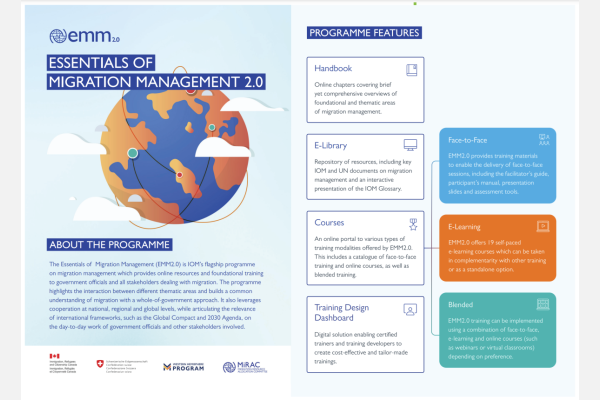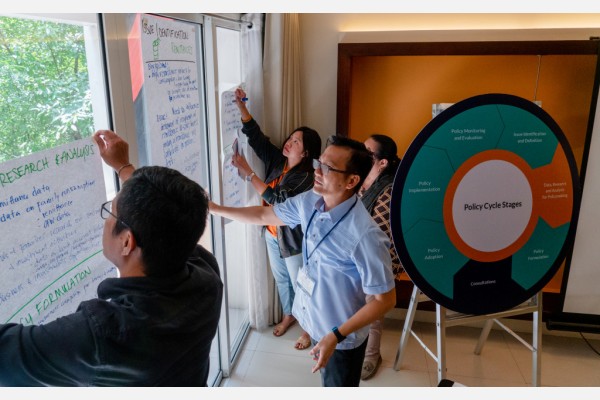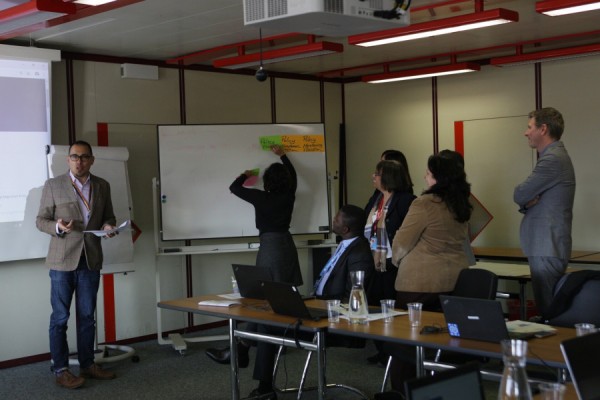Repository of Practices

The Essentials of Migration Management (EMM2.0)
Dates
Type of practice
Geographic scope
Geographic Scope:
Summary
IOM launched the original version of the programme in 2004. However, given that its resources had fallen into limited use over the years, the updated version of the programme was developed in 2018 (rebranded as EMM2.0). While building on its successful predecessor, EMM2.0 combined new trends in the field and marked the crucial shifts in the overall governance of international migration, including the GCM.
The aim of this capacity development tool is to provide online resources and foundational training to government officials and all stakeholders dealing with migration. The programme highlights the interaction between different thematic areas and builds a holistic understanding of migration with whole-of-government and whole-of-society approaches. The programme also leverages cooperation at national, regional and global levels, while articulating the relevance of international frameworks on the day-to-day work of government officials and other stakeholders involved.
The programme offers the following features:
• Handbook: Online chapters providing brief yet comprehensive overviews of different topics on migration management.
• E-library: A repository of essential resources, including key IOM and other UN documents on migration management.
• Courses: Various types of training modules which can be delivered face-to-face, online or through a blended modality, including in self-paced e-learning format.
Organizations
Main Implementing Organization(s)
Detailed Information
Benefit and Impact
Given the wide range of thematic modules covered, EMM2.0 provides an important opportunity for dialogues on migration, and for identifying areas of coordination between different government ministries, agencies and institutions. By bringing together stakeholders involved in different migration thematic areas, EMM2.0 highlights the interaction between various policy sectors, building a holistic understanding of migration with whole-of-government and whole-of-society approaches.
The impacts are measured through pre- and post-training evaluations assessing the increase in participants’ skills and knowledge in various aspects of migration management. From this foundation, the programme’s sustainability is evaluated based on whether the increased knowledge/skills, as a result of EMM2.0, would improve participants’ work performance. Further, with regards to the programme’s relevance, we assess the extent to which EMM2.0 content is well matched with the job-related needs of migration policymakers and programme implementers, and whether they plan to use the information presented in EMM2.0 beyond the training event.
Key Lessons
The added value of EMM2.0 is its global orientation. While it proposes policy options and good practices that have been found to be broadly useful over time, it does not seek to prescribe a “one-size-fits-all” approach. Instead, it recognizes that every situation is different. To this end, the programme team based in HQ works closely with field offices in preparation of each training to ensure that the content is well matched to the job-related needs of the target audience. The global training programme/standardized materials are also contextualized with local examples in order to reflect the regional/national specificities and conditions, making the learning experience fully relevant, useful and interesting to the course participants.
Recommendations(if the practice is to be replicated)
• Ensure a diverse list of participants involved in different areas of migration management. This would give EMM2.0 training an added value by offering a unique opportunity to get acquainted with each other and realize the interdependency of their work across divisions, departments and organizations, irrespective of their specific mandates. Contacts made during EMM2.0 events have encouraged cooperation in the future. Participation of female government officials in training events is highly encouraged.
• Select an adequate team of trainers with sufficient facilitation experience and know-how to deliver EMM2.0 sessions. If needed, run a training-of-trainers (ToT) session to certify them.
• Create a training curriculum based on participants’ priority areas and training needs. One method of needs assessment is through a pre-training questionnaire.
• Consolidate results of post-training evaluations to assess the knowledge and skills gained, as well as areas for improvement.
Innovation
Additional Resources
Media
Message from Department of Programme Support and Migration Management Director
Additional Images
Date submitted:
Disclaimer: The content of this practice reflects the views of the implementers and does not necessarily reflect the views of the United Nations, the United Nations Network on Migration, and its members.
More Related Practices:
- Kenya GCM Implementation Plan (2023-2027)
- Evaluando el Pacto Mundial para la Migración Segura, Ordenada y Regular: Propuesta de Indicadores de la Sociedad Civil
- Regional Migrant Response Plan (MRP) for the Horn of Africa and Yemen
- Regional Inter-Agency Coordination Platform for Refugees and Migrants from Venezuela (R4V)
- Media as a tool of advocacy and supporting mechanism
Peer Reviewer Feedback:
*References to Kosovo shall be understood to be in the context of United Nations Security Council resolution 1244 (1999).
Newsletter
Subscribe to our newsletter.


